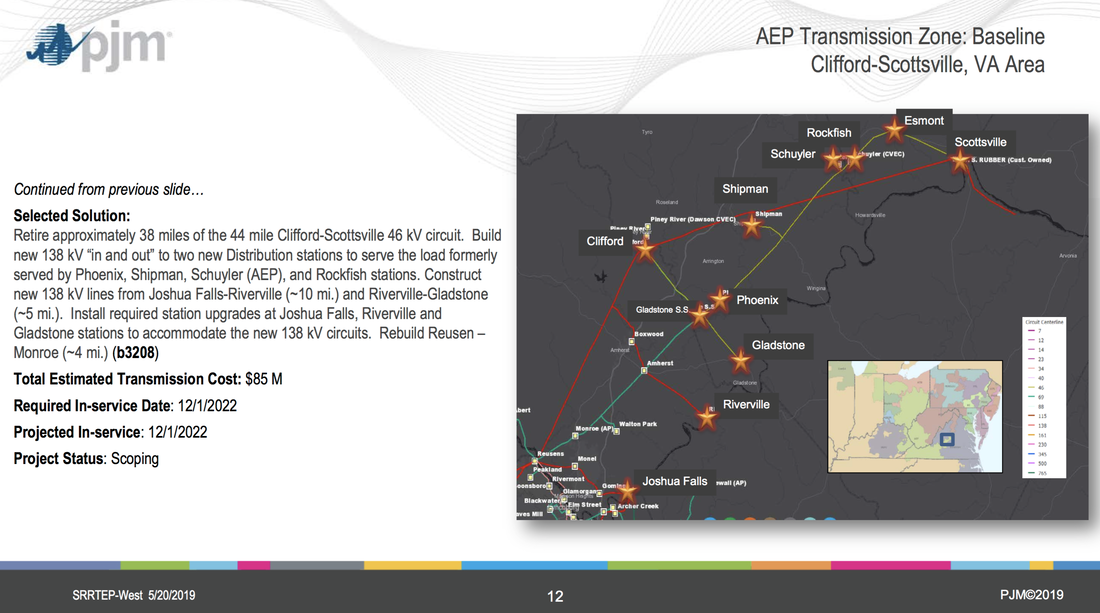A community is blind-sided by a new transmission proposal. The transmission company herds them into one of their "Open House" dog and pony shows, where the landowners glare at transmission employees with arms folded in news photos. The news media is there to report the story and get quotes from the landowners (because, hey, dirty laundry sells). The landowners then begin to gather, both in and outside the meeting. Information is exchanged, and a transmission opposition group is born.
I got my best piece of advice ever at one of these Open House meetings. The sympathetic transmission company guy innocently told me "Make a lot of noise." Damn straight, Skippy!
So, what's this project? The Central Virginia Reliability Project is the brainchild of American Electric Power's Appalachian Power Co. The news dutifully parroted ApCo's project spiel:
The project is designed to provide a new electricity source for the region with the construction of 15 miles of transmission lines and improvements to four substations in Amherst, Appomattox, Campbell and Nelson counties.
The completed transmission line would strengthen the local power grid, increase reliability to the area and reduce the likelihood of power outages, according to APCo spokesperson George Porter. He said Albemarle, Appomattox, Amherst, Campbell and Nelson counties all would see increased service reliability.
New electricity source? Not hardly. ApCo is simply re-routing existing transmission lines that have reached the end of their useful life. Instead of simply rebuilding them, they had a better idea. But it's not a new power supply.
Except PJM didn't really tell them to do this, at least not in this way. Here's how the project dreamed up by ApCo was presented to PJM:
There are also supplemental needs in the area that were evaluated together with the baseline violations. The supplemental needs in the area are driven by equipment condition for the Amherst – Clifford 69 kV and Clifford – Scottsville 46 kV circuits. The lines were built in 1960 and 1926 respectively, on wood pole structures and have many open conditions due to rot, woodpecker/insect damage, split poles, broken insulators, and damaged shield wire. The recommended solution addresses both the baseline and supplemental needs in the area and is the most cost effective. The estimated cost for this project is $85 million, and the required in-service date is December, 2022. Based on their FERC 715 TO Criteria, the local transmission owner, AEP, will be designated to complete this work.
Gotta wonder... did PJM do a "constructability analysis" on this project to see if it was feasible? I don't see it. Guess PJM figured the landowners in "central Virginia" would just go along like happy little campers.
And all that blather about reliability? It's designed to make you think that your lights are going to go off if this project doesn't happen. It's designed to make you remember all those times that your power went off during storms. It's designed to make you think that you will experience less outages if this transmission line is built. Except that's not reality. Most power outages happen on the distribution system, not the transmission system. It's the network of local power lines that bring power to your home, and not the big transmission lines that move it around between substations, where the vast majority of power outages happen. The power will still go out in your house when that system fails.
The News & Advance reports:
Along the multiple possible routes, more than 300 landowners had the potential to be effected — largely by the 70- to 90-foot galvanized steel poles that would be constructed to carry the transmission lines.
Martin’s neighbors, Bill and Cole Carney, harbor similar fears. One of the proposed routes would cut through their property. Owners of the 1851 plantation home that gave Tin Top Place its name, they have been on the property for about a year. Budding farmers with plans to expand and potentially start an organic farm, Bill Carney said it will render swathes of their land useless, force acres of woods to be cut down and prevent them from moving forward with plans for the farm.
“How are we supposed to sell products if we have an industrial power line coming through our supposed organic fields?” said Cole Carney. “We never would have bought had we known this was coming.”
It remains to be seen how much noise this community can make. When it happens, it can be magic.

 RSS Feed
RSS Feed